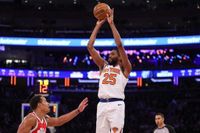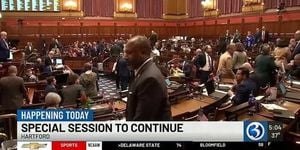The New York Knicks, fresh off their first Eastern Conference Finals appearance in a quarter-century, are facing a brand new kind of challenge as the 2025-26 NBA season approaches: a financial squeeze so tight, it’s reshaping their roster strategy and putting the front office’s creativity to the test. The Knicks, who captured headlines last year with blockbuster trades for Mikal Bridges and Karl-Anthony Towns, now find themselves just $3.72 million below the NBA’s dreaded second apron hard cap. That means they’re not just pinching pennies—they’re counting every cent as they try to fill out their roster and keep championship dreams alive.
New York’s summer has been anything but quiet. After a thrilling playoff run that saw the team reach the conference finals for the first time since the late 1990s, the front office doubled down on its core. Bridges, who arrived last year amid sky-high expectations, inked a four-year, $150 million extension that kicks in for the 2026-27 season. The deal, which includes a fourth-year player option and a 5.69% trade kicker, was seen as a necessary move after the Knicks surrendered a trove of first-round picks to land him. According to Hoops Rumors, the extension comes at a slight discount—about $1.5 million per year under the maximum allowable—potentially a crucial margin as the Knicks navigate the luxury tax minefield in the years ahead.
But while the core of Bridges, Towns, Jalen Brunson, OG Anunoby, and Josh Hart remains intact, the supporting cast has seen some notable changes. Guerschon Yabusele was brought in on a two-year, $11,275,000 deal using the taxpayer mid-level exception, a move that raised eyebrows given the team’s cap constraints. Yabusele, who impressed in Philadelphia last season with averages of 11.0 points, 5.6 rebounds, and 2.1 assists on efficient shooting, is expected to fill the frontcourt void left by Precious Achiuwa, who remains unsigned. “The hope in New York is that Brown will feel more confident deploying Yabusele than Thibodeau did with Achiuwa,” Hoops Rumors noted, referencing the coaching change that saw Tom Thibodeau replaced by Mike Brown after criticism of Thibodeau’s tight rotations and reluctance to develop young talent.
Brown’s arrival signals a new era for the Knicks—one where maximizing the talents of a deep roster is paramount, especially given the financial constraints. The Knicks also signed Jordan Clarkson to a one-year minimum contract after his buyout from Utah, hoping the veteran guard can inject some much-needed scoring into a bench unit that finished dead last in the league last season with just 21.7 points per game. Clarkson, though past his prime, has maintained a respectable 16.8 points per game average since the start of the 2023-24 campaign and brings a proven scoring punch to a team desperate for bench production.
Yet, for all the positive moves, the Knicks’ roster math remains precarious. As of late August, the team carries just 12 players on standard contracts. With only $3.72 million in breathing room below the second apron, New York can sign just one free agent to a minimum-salary deal ($2,296,274), and even that move requires precision. Filling the 14th roster spot is even trickier: the player must be someone whose draft rights the Knicks already hold, signed to a rookie minimum contract ($1,272,870). Candidates include James Nnaji, Hugo Besson, Rokas Jokubaitis, and 2025 second-round pick Mohamed Diawara. Of this group, Nnaji and Diawara are reportedly preparing to join the Knicks after leaving their European teams this summer, with one likely to sign a standard contract and the other potentially landing a two-way slot.
But what if the Knicks want to take a different route for the 14th spot or add a more experienced hand? That’s where things get complicated. According to Luke Adams of Hoops Rumors, “There’s technically a way the Knicks could take a different route with that 14th roster spot, but it would require the team to shed some salary, either via trade or using the stretch provision (the latter will only be an option for a few more days).” The most obvious candidate for a cost-cutting trade is 2024 first-round pick Pacome Dadiet, whose $2,847,600 salary is above the minimum and whose rookie year saw limited playing time. Shedding Dadiet’s salary could open the door to a different kind of addition—perhaps a veteran presence or a player who doesn’t fit the strict draft-rights criteria.
Meanwhile, the Knicks’ search for a 13th man has generated its own buzz. Veteran free agents Landry Shamet, Ben Simmons, Malcolm Brogdon, and Malik Beasley have all been mentioned as possible targets, with Beasley emerging as a top option—provided he’s cleared in the ongoing federal gambling investigation. “I get the sense that Beasley would be their top target if it looks like he’s in the clear,” a Hoops Rumors update stated, though Beasley may command more than the minimum salary if other suitors get involved. For now, the Knicks’ options remain limited by the hard cap, and any addition must be carefully weighed against the team’s financial reality.
Of course, the Knicks’ offseason hasn’t just been about arrivals. Several players have departed or remain unsigned, including Achiuwa, MarJon Beauchamp, Kevin McCullar Jr., Cameron Payne, P.J. Tucker, Anton Watson, and Delon Wright. The team also exercised a $1,955,377 option on Ariel Hukporti, maintaining some continuity in the frontcourt. With the roster in flux and two-way slots still unfilled, competition for the final spots is expected to be fierce. Former G League Ignite prospect Dink Pate is reportedly set to sign an Exhibit 10 contract, adding intrigue to training camp battles.
All of this roster maneuvering comes against the backdrop of a Knicks team that’s pushed its chips to the center of the table. After years of rebuilding and near-misses, the front office has gone all-in on a star-studded core, sacrificing future draft capital and financial flexibility in pursuit of a title. The pressure is on new head coach Mike Brown to get the most out of this group, especially with expectations soaring after last season’s deep playoff run.
Looking ahead, the Knicks’ tightrope walk under the salary cap shows no signs of easing. Mitchell Robinson, a key defensive anchor, is extension-eligible, but with the team’s payroll already ballooning, any new deal will require careful negotiation. For now, the front office’s focus is squarely on filling out the roster without tripping the second apron—a task that could force tough decisions and perhaps a trade or two before the deadline.
As the NBA offseason barrels toward its conclusion, all eyes are on Madison Square Garden. Will the Knicks’ financial high-wire act pay off with another deep playoff run, or will the constraints of the second apron prove too steep a hurdle? One thing’s for sure: the roster drama in New York is far from over, and the next few weeks could bring even more twists to an already compelling story.





